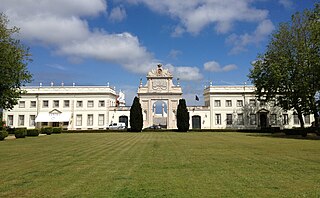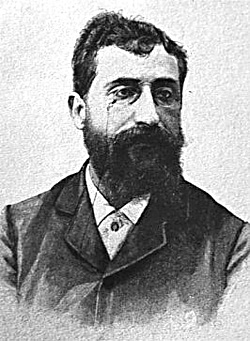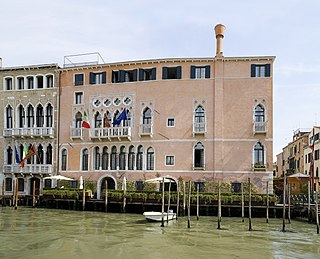
The Villa Farnese, also known as Villa Caprarola, is a pentagonal mansion in the town of Caprarola in the province of Viterbo, Northern Lazio, Italy, approximately 50 kilometres (31 mi) north-west of Rome, originally commissioned and owned by the House of Farnese. A property of the Republic of Italy, Villa Farnese is run by the Polo Museale del Lazio. This villa is not to be confused with two similarly-named properties of the family, the Palazzo Farnese and the Villa Farnesina, both in Rome.

Liberty style was the Italian variant of Art Nouveau, which flourished between about 1890 and 1914. It was also sometimes known as stile floreale, arte nuova, or stile moderno. It took its name from Arthur Lasenby Liberty and the store he founded in 1874 in London, Liberty Department Store, which specialized in importing ornaments, textiles and art objects from Japan and the Far East. Major Italian designers using the style included Ernesto Basile, Ettore De Maria Bergler, Vittorio Ducrot, Carlo Bugatti, Raimondo D'Aronco, Eugenio Quarti, and Galileo Chini.

The Teatro Massimo Vittorio Emanuele is an opera house and opera company located on the Piazza Verdi in Palermo, Sicily. It was dedicated to King Victor Emanuel II. It is the biggest in Italy, and one of the largest of Europe, renowned for its perfect acoustics.

The University of Palermo is a public research university in Palermo, Italy. It was founded in 1806, and is currently organized in 12 Faculties.

The Palazzo Ducale di Mantova is a group of buildings in Mantua, Lombardy, northern Italy, built between the 14th and the 17th century mainly by the noble family of Gonzaga as their royal residence in the capital of their Duchy. The buildings are connected by corridors and galleries and are enriched by inner courts and wide gardens. The complex includes some 500 rooms and occupies an area of c. 34,000 m2, which make it the sixth largest palace in Europe after the palaces of the Vatican, the Louvre Palace, the Palace of Versailles, the Royal Palace of Caserta and the Castle of Fontainebleau. It has more than 500 rooms and contains seven gardens and eight courtyards. Although most famous for Mantegna's frescos in the Camera degli Sposi, they have many other very significant architectural and painted elements.

Giugliano in Campania, also known simply as Giugliano, is a city and comune (municipality) in the Metropolitan City of Naples, Campania, Italy. A suburb of Naples, as of 2017, it had some 124,000 inhabitants, making it the most populated Italian city that is not a provincial capital.

Orta San Giulio is a town and comune (municipality) in the Province of Novara in the Italian region of Piedmont, located about 100 kilometres (62 mi) northeast of Turin and about 40 kilometres (25 mi) northwest of Novara. It is one of I Borghi più belli d'Italia.

Civitanova Marche is a comune (municipality) in the Province of Macerata in the Italian region Marche, located about 40 kilometres southeast of Ancona and about 25 km (16 mi) east of Macerata.

The Seteais Palace is a neoclassical palace located in Sintra, on the Portuguese Riviera, operating as a luxury hotel known as the Tivoli Palácio de Seteais Hotel. The palace is a national landmark and is included in the UNESCO Cultural Landscape of Sintra World Heritage Site listing.

Ernesto Basile was an Italian architect and an exponent of modernisme and Liberty style, the Italian variant of Art Nouveau. His style was known for its eclectic fusion of ancient, medieval and modern elements.

Mandarin Oriental, Lake Como is a 5 star luxury resort located in Blevio in the province of Como, Italy. The estate is also known formerly as CastaDiva before its refurbishment in the late 2010s and subsequent transferral of ownership to its current owner, Hong Kong-based multinational chain Mandarin Oriental Hotel Group. The heart of the entire resort consists of the Villa Roccabruna, which was notably where composer Vincenzo Bellini wrote his two most famous works: La Sonnambula and Norma.

Villa Contarini, also known as Vigna Contarena, is a villa in Este, Province of Padua, in the Veneto region of northern Italy. The name Vigna Contarena seems to come from the fruit trees and vines originally cultivated in the park of the villa, situated at the foot of the Euganean Hills. The villa was built in the first years of the 17th century and served both residential and agricultural purposes, with the ground floor destined for storage and labor uses, while the first floor, or piano nobile, contained the living quarters and formal rooms.

The Ca' Sagredo is a 14th-century Byzantine-Gothic style palace located on the corner of the Strada Nuova and Campo Santa Sofia, in the sestiere of Cannaregio in central Venice, Italy. It now faces the Grand Canal (Venice), and across the campo from the Ca' Foscari. On the left side there is the Palazzo Giustinian Pesaro.

Villa Malfitano Whitaker is a 19th-century villa in Via Dante, in the quarter of Politeama of Palermo, Sicily. It is presently a museum displaying Whitaker's natural history and archaeological collections, as well as his artwork.

The Villa San Girolamo, sometimes known as the Church of San Girolamo, is a building complex that includes a villa, olive grove, and former Catholic monastery and church located on Via Vecchia Fiesolana in Fiesole, Tuscany.

The Palazzo del Giardino or Palazzo Ducale del Giardino is a historic palace in the Parco Ducale in Parma. It is not to be confused with the official Parma residence of Marie Louise, Duchess of Parma between Palazzo della Pilotta and Palazzo della Provincia in what is now known as piazzale della Pace - she also lived at the Ducal Palace of Colorno and in the Casino dei Boschi in Sala Baganza. The main Ducal Palace in Parma, the Palazzo della Pilotta and the Reinach Theater were all destroyed in an early morning air raid on 13 May 1944, carried out by the 465th Heavy Bombardment Group of the US Airforce, 781st Squadron, which dropped 9 GP bombs on the city centre.

Villa Zito is an 18th-century palace located on Via della Liberta #52 in Palermo, region of Sicily, Italy. The structure is now owned by the Fondazione Sicilia and serves as their museum gallery and exhibition space for their collection of artworks, mainly graphic works and paintings, by mainly Sicilian artists from the 17th to the early 20th century.

The Antico Stabilimento Balneare located in Mondello, a seaside borough north of Palermo, Sicily, is an Art Nouveau or Liberty-style building atop piers of the beach in the town. The term balneare is related to the Spanish and Portuguese Balneario which is either a swimming or beach establishment, but also with affinities to spas, with amenities such as changing rooms, cabanas, bathrooms, and eating establishments.

Villino Florio is a private residence designed in an eclectic Art Nouveau (Liberty) style by Ernesto Basile, and located on Viale Regina Margherita #38 in the city of Palermo, Siciy, Italy.

The Rocca Sanvitale or Sanvitale Castle of Sala Baganza is a fortress/palatial residence located on Piazza Gramsci #1, overlooking the small town of Sala Baganza, just southwest of Parma, region of Emilia-Romagna, Italy. It is distinct from the more-visited moated castle of Rocca Sanvitale, Fontanellato.





















